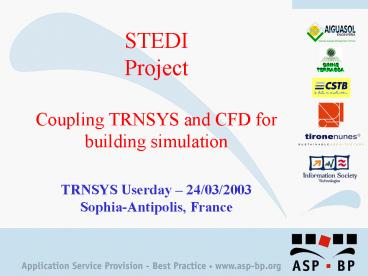STEDI Project Coupling TRNSYS and CFD for building simulation - PowerPoint PPT Presentation
1 / 20
Title:
STEDI Project Coupling TRNSYS and CFD for building simulation
Description:
Evaluation of TRNSYS and GiD-FAUST by the second level end-users (architects) To know the features offered by SIMCAD-TRNSYS and GiD-FAUST. ... – PowerPoint PPT presentation
Number of Views:429
Avg rating:3.0/5.0
Title: STEDI Project Coupling TRNSYS and CFD for building simulation
1
STEDIProjectCoupling TRNSYS and CFD for
building simulation
TRNSYS Userday 24/03/2003 Sophia-Antipolis,
France
2
ASP-BP Application Service ProvisionBest
Practice
- European framework
- 6 projects focused on ASP technology-based
applications in different industrial field. - Duration 2 years
- Funded by the European Union under the IST
programme within Fifth Framework programme.
3
Objectives
- To adapt two thermal behaviour simulation
software - GiD-FAUST (CFD)
- SIMCAD-TRNSYS
- (Dynamic Transient Simulation)
- To create a new ASP model STEDI
- (version of GiD-FAUST coupled to SIMCAD-TRNSYS)
4
Objectives
- To demonstrate the use of this applications
through Intensive validation and dissemination
plan. - Essential role of end-users in the project
5
Flow diagram of tasks
6
Coupling between toolsInitial vision
MULTI-ZONE COMPUTATION
CFD COMPUTATION
7
Coupling between toolsInitial vision
8
Identification user requirements and objectives
- Define the end-users needs
- Define required tests and measurements needed to
ensure a good performance and reflect the
benefits of STEDI - Information exchange platform
9
Training and initial evaluation
- Evaluation of TRNSYS and GiD-FAUST by the second
level end-users (architects) - To know the features offered by SIMCAD-TRNSYS and
GiD-FAUST. - To have enough knowledge for a proper
continuation of the project.
10
Specification of second level users needs
- Fully specifying the second level user needs
concerning GiD features and the web computing
service. - Starting points information and requirements
defined in Task 3 - Experience gained during the initial evaluation
period in Task 4
11
Conclusions
- The more important factors for the program hit
- producing useful outcomes
- simple to use
- quickly understandable
- Pre-checking tool at the early design phase
12
Outcomes definition
- Graphical Outcomes CFD Computations
- Room distribution temperature
- Distribution of air velocity vectors
- Distribution of comfort values
13
Outcomes definition
- Global Building results
- Heating Cooling loads
- Average Daily temperatures
- Hourly zone temperatures
14
Outcomes definition
- Evaluation Process
- Identification of critical situation in the
overall building graphics - Analyse the CFD of more critical situations
15
Coupling between toolsSTEDI v1.0
16
Plans for STEDI v1.0
- First version, May 2003
- Validation and test until October
- Revised version October 2003
17
Project Risks
- Dissemination
- know about the existence of the ASP model.
- Links to the STEDI Web page on the most important
Web-Sites - Publicity in architectural reviews.
- Clarity
- The Potential users of the STEDI service have to
be attracted by STEDI. - The risk is that potential users wont understand
the aims of the service.
18
Project Risks
- Economical Risks
- Cost of the ASP service.
- Internet Connection
- Minimum standard of internet connection.
- Technical Risks
- Too complicated to draw the building Model
- Guide for STEDI. Insufficient libraries.
- Outcomes not right or incomprehensible.
19
Dissemination. Web page
http//www.cimne.upc.es/stedi/default.asp
20
Contact
- AIGUASOL Enginyeria
- Jordi Pascual jordi_at_aiguasol.com
- C/ Palau, 4, 2º 2ª
- 08002 BARCELONA
- This project is supported in the Fifth Framework
programme by the European Commission in the IST
initiative and is included in the cluster of
projects ASP-BP (www.asp-bp.org) regarding
Application Service Provision technology applied
in real industrial environments































